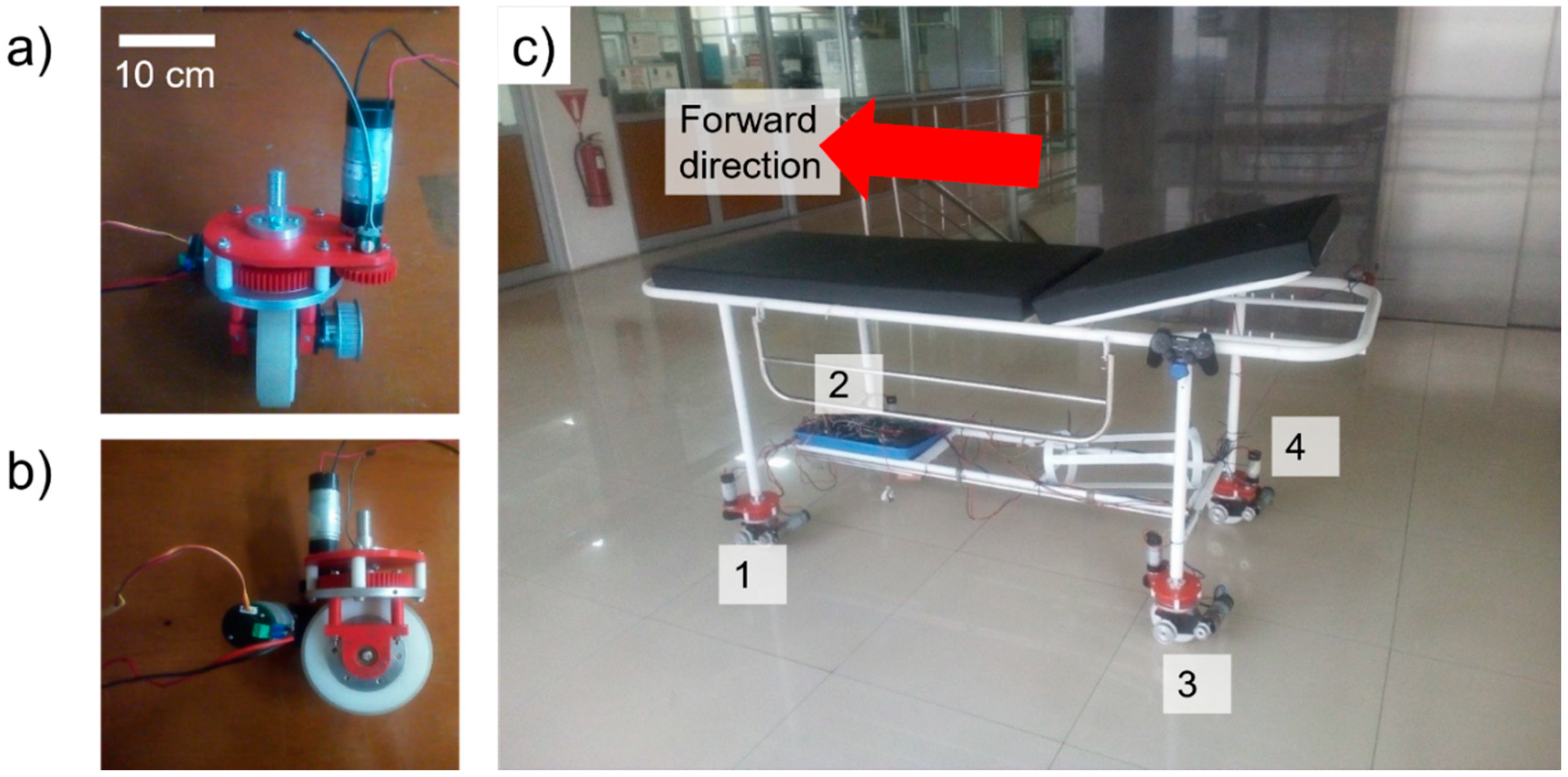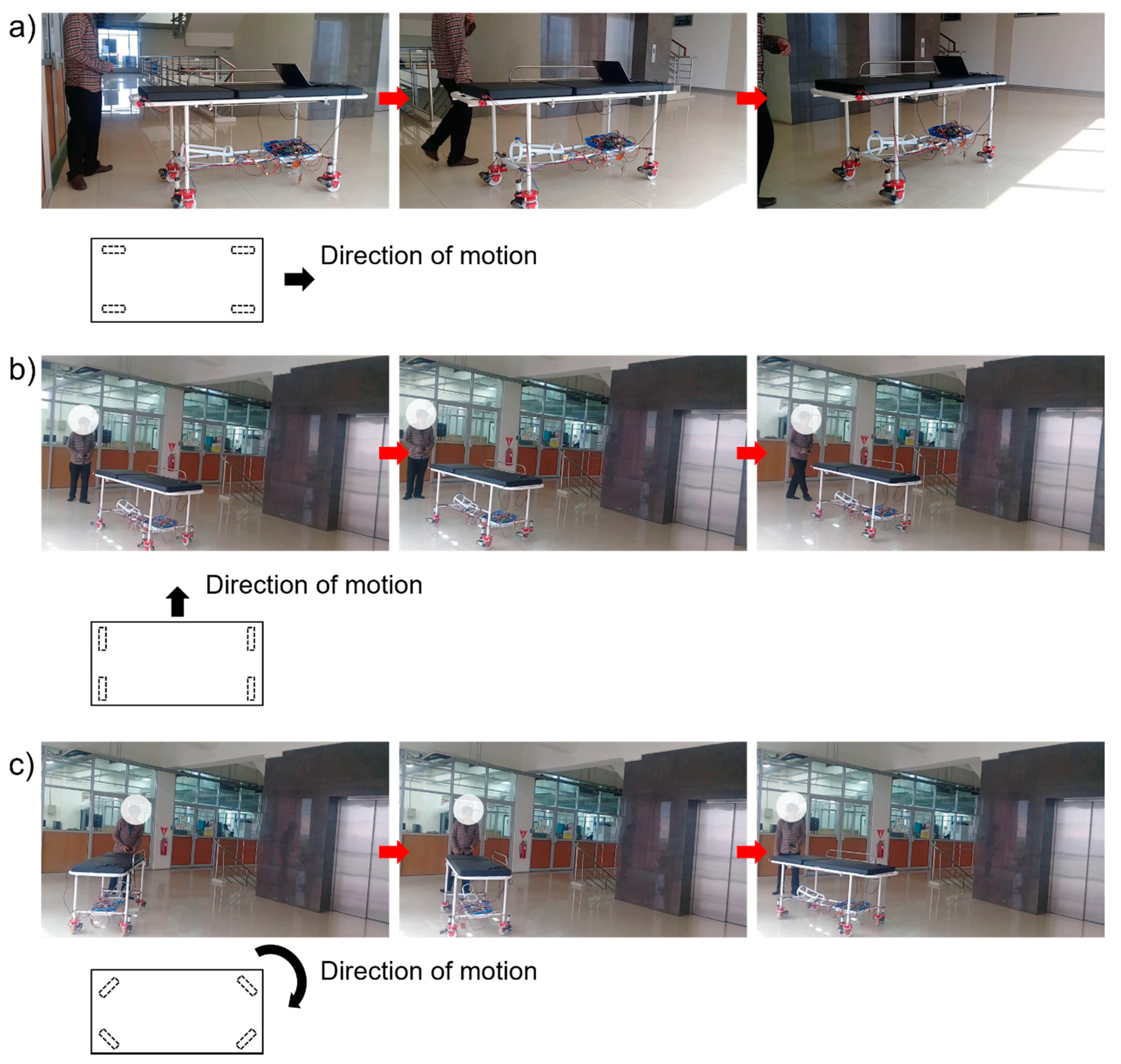Development of a Motorized Hospital Bed with Swerve Drive Modules for Holonomic Mobility
Abstract
:1. Introduction
2. Designs and Methods
2.1. Mechanical Design
2.2. Electrical Design
3. Results and Discussion
3.1. Fabrication of the Prototype and PID Tuning of the Propulsion Motor
3.2. Velocity Response, Error Characterization, and Demonstration
4. Conclusions
Supplementary Materials
Author Contributions
Funding
Conflicts of Interest
References
- Ando, S.; Ono, Y.; Shimaoka, M.; Hiruta, S.; Hattori, Y.; Hori, F.; Takeuchi, Y. Associations of self estimated workloads with musculoskeletal symptoms among hospital nurses. Occup. Environ. Med. 2000, 57, 211. [Google Scholar] [CrossRef] [PubMed] [Green Version]
- Dutta, T.; Holliday, P.J.; Gorski, S.M.; Baharvandy, M.S.; Fernie, G.R. A biomechanical assessment of floor and overhead lifts using one or two caregivers for patient transfers. Appl. Ergon. 2012, 43, 521–531. [Google Scholar] [CrossRef] [PubMed]
- Holtermann, A.; Clausen, T.; Jørgensen, M.B.; Burdorf, A.; Andersen, L.L. Patient handling and risk for developing persistent low-back pain among female healthcare workers. Scand. J. Work. Environ. Health 2013, 39, 164–169. [Google Scholar] [CrossRef] [PubMed] [Green Version]
- Leban, B.; Lecca, L.I.; Fabbri, D.; Campagna, M.; Pau, M. Influence of trajectory and gender on pushing-pulling forces when maneuvering beds in actual hospital paths. Mater. Today Proc. 2019, 7, 435–442. [Google Scholar] [CrossRef]
- Risk, J.R., Jr. Siderail Pad for Hospital Bed. U.S. Patent 6,928,673, 16 August 2005. [Google Scholar]
- Weismiller, M.W.; Kummer, J.A.; Wukusick, P.M.; Branson, G.W.; Kramer, K.L.; Schulte, S.R.; Palermo, P.D.; Thomas, J.M.; Dlugos, D.F., Jr.; Butterbrodt, J.T.; et al. Hospital Bed and Mattress Having Extendable Foot Section. U.S. Patent 7,213,279, 8 May 2007. [Google Scholar]
- Foster, L.D.; Breidenbach, J.H. Hospital Bed with Collapsible side Edges and Laterally-Movable Side Guards. U.S. Patent 5,083,332, 28 January 1992. [Google Scholar]
- Rudolf, K.O.; Williams, D.W. Hospital Bed Castor Control Mechanism. U.S. Patent 5,377,372, January 1995. [Google Scholar]
- Menkedick, D.J.; Osborne, E.E.; Zerhusen, R.M.; Albersmeyer, D.A.; Philbeck, R.S.; Bhai, A.A.; Batta, N.C.; Richter, T.L.; Riggs, T.; Chambers, K.W.; et al. Hospital Bed Including Moveable Foot Portion. U.S. Patent 7,520,006, 21 April 2009. [Google Scholar]
- Megown, M.W. Height and Angle Adjustable Bed Having a Rolling Base. U.S. Patent 6,405,393, 1 May 2000. [Google Scholar]
- Wang, C.; Savkin, A.V.; Clout, R.; Nguyen, H.T. An intelligent robotic hospital bed for safe transportation of critical neurosurgery patients along crowded hospital corridors. IEEE Trans. neural Syst. Rehabil. Eng. 2014, 23, 744–754. [Google Scholar] [CrossRef] [PubMed]
- Wang, C.; Matveev, A.S.; Savkin, A.V.; Clout, R.; Nguyen, H.T. A semi-autonomous motorized mobile hospital bed for safe transportation of head injury patients in dynamic hospital environments without bed switching. Robotica 2016, 34, 1880–1897. [Google Scholar] [CrossRef]
- Guo, Z.; Yee, R.B.; Mun, K.R.; Yu, H. Experimental evaluation of a novel robotic hospital bed mover with omni-directional mobility. Appl. Ergon. 2017, 65, 389–397. [Google Scholar] [CrossRef]
- Guo, Z.; Xiao, X.; Yu, H. Design and evaluation of a motorized robotic bed mover with omnidirectional mobility for patient transportation. IEEE J. Biomed. Health Inform. 2018, 22, 1775–1785. [Google Scholar] [CrossRef]
- Hospimek “Motorized Patient Trolley”. Available online: http://www.hospimek.com.sg/hmpt-740 (accessed on 27 November 2021).
- Yang, G.; Li, Y.; Lim, T.M.; Lim, C.W. Decoupled powered caster wheel for omnidirectional mobile platforms. In Proceedings of the 2014 9th IEEE Conference on Industrial Electronics and Applications, Hangzhou, China, 9–14 June 2014; pp. 954–959. [Google Scholar]
- Glowinski, S.; Krzyzynski, T.; Bryndal, A.; Maciejewski, I. A kinematic model of a humanoid lower limb exoskeleton with hydraulic actuators. Sensors 2020, 20, 6116. [Google Scholar] [CrossRef]







Publisher’s Note: MDPI stays neutral with regard to jurisdictional claims in published maps and institutional affiliations. |
© 2021 by the authors. Licensee MDPI, Basel, Switzerland. This article is an open access article distributed under the terms and conditions of the Creative Commons Attribution (CC BY) license (https://creativecommons.org/licenses/by/4.0/).
Share and Cite
Dhelika, R.; Hadi, A.F.; Yusuf, P.A. Development of a Motorized Hospital Bed with Swerve Drive Modules for Holonomic Mobility. Appl. Sci. 2021, 11, 11356. https://doi.org/10.3390/app112311356
Dhelika R, Hadi AF, Yusuf PA. Development of a Motorized Hospital Bed with Swerve Drive Modules for Holonomic Mobility. Applied Sciences. 2021; 11(23):11356. https://doi.org/10.3390/app112311356
Chicago/Turabian StyleDhelika, Radon, Ali Fajar Hadi, and Prasandhya Astagiri Yusuf. 2021. "Development of a Motorized Hospital Bed with Swerve Drive Modules for Holonomic Mobility" Applied Sciences 11, no. 23: 11356. https://doi.org/10.3390/app112311356
APA StyleDhelika, R., Hadi, A. F., & Yusuf, P. A. (2021). Development of a Motorized Hospital Bed with Swerve Drive Modules for Holonomic Mobility. Applied Sciences, 11(23), 11356. https://doi.org/10.3390/app112311356





